Starting can be crippling. The blank canvas. The blank page. $0 in revenue on your sales report. All are discouraging.
Where do we begin?
In those situations, we want answers. Well, at least a path forward. What should we be doing to get started? Then, what activities should we do that are going to lead us in the direction we want to go?
That is exactly why I want to provide you with this guide. To show you the system I have used, more than once, to build businesses. And, have implemented for teams to increase sales.
Starting with principles. Then, building those into an executable process, with some tactics baked in. All geared towards getting you to increase your sales.
What will you learn?
In this guide, I will provide you with a blue print to increase your sales revenue. From $0 to managing your first clients. All through selling. Then, continuing to increase your sales while managing and leveraging your new clients.
This is for the sales professional. The founder. The early employee who has to generate the businesses first consistent sales pipeline.
If you are looking for a playbook to build your business, then this is for you.
Download our sales zone planner here.
Planning to increase your sales
To increase your sales with a consistent pipeline, you need a solid planning process. This seems obvious, but I’m going to provide you with a structure to get started. Then, you can build and craft this plan to make it work for you.
Planning falls into three categories. Understanding your territory, finding target accounts, and building your schedule. Let’s dive into each.
Understand your territory
Everyone has a territory. Some are defined. For example, outside sales professionals have a defined geographical territory. Others are undefined. For example, tech companies getting started.
I have been in both, defined and undefined territories. We’re going to understand both situations. Let’s begin with a defined territory.
Defined territory
In a defined geographic territory, you have a nice set of constraints. To understand the territory, we want to understand its geography. Then, understand where our business opportunity lies within that geography.
We do this so we can control our days and our schedule. If you are an outside sales professional, you do not want to drive in a “star”.
The “star concept” looks like this:
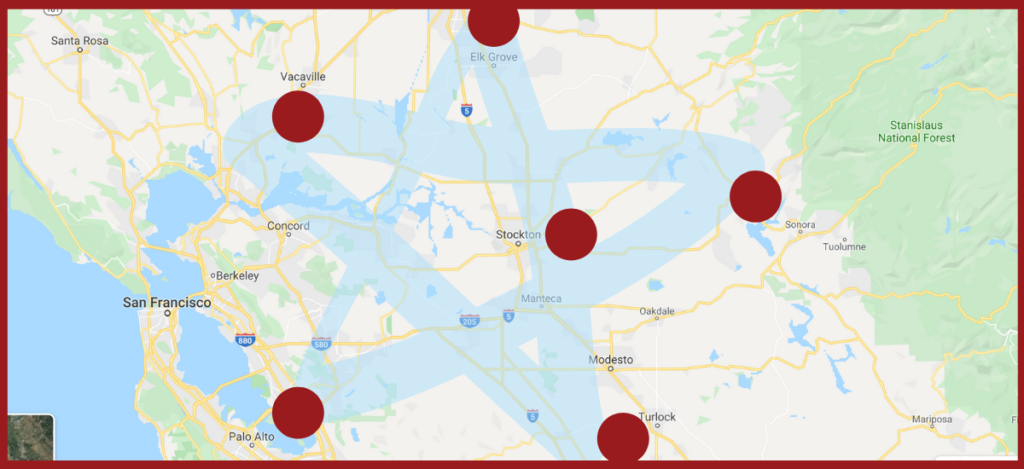
We want to avoid duplicate and inefficient travel. We do this by breaking our territory up into zones. The size of your territory will depend on how you break up your zones.
For our example here, I want to use a 5-zone system, which is the exact system I have used. To build this 5-zone system, we want to get a map of our territory.
Take a screen shot on Google Maps. With that map, we are going to draw our zones. You’ll want to determine zones based on what makes sense for your specific territory.
To do this, either print out the map and physically draw the zones, or you can use your photos app or Canva. The result should look something like this:
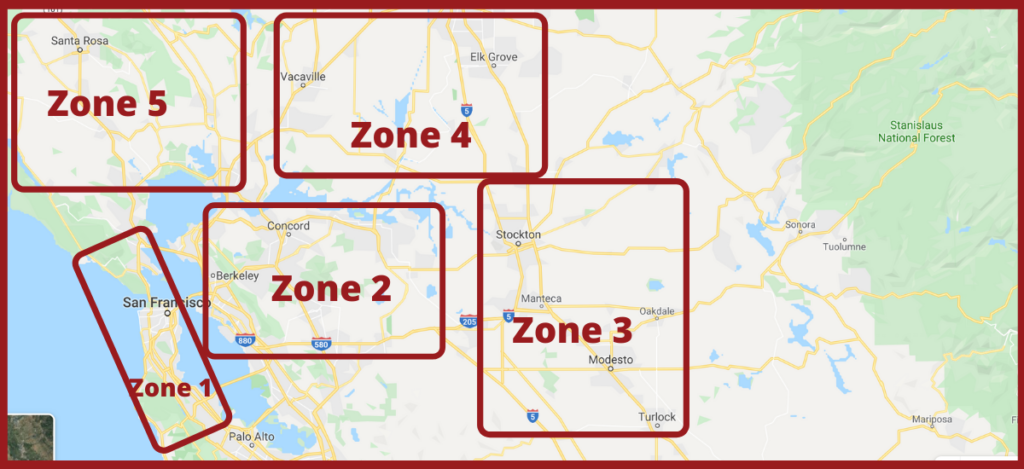
You can build your zones with our sales planner here.
This map is going to be the foundation for everything you do later. Make sure it is a meaningful representation of your territory.
Undefined territory
For those that don’t have a defined geographic territory like this, we can still use the same concept. This is common for tech sales professionals. We are going to artificially create it. This way, we can bring structure to our efforts.
I am going to use an extreme example where the whole world is your territory. To manage this, we are going to think in regions and time zones. You do not want to work all day and night. To avoid this, we will structure you to work within specific time zones.
For simplicity, let’s say your office is in New York. Realistically, you’re going to cover the U.S., Canada, and the EU. To make sense of this, we want to create a 3-zone system based on time zones.
We’ll create:
- West Coast
- East Coast
- EU
Then, you work each of those zones when you best overlap.
Your “territory map” is going to look something like this:
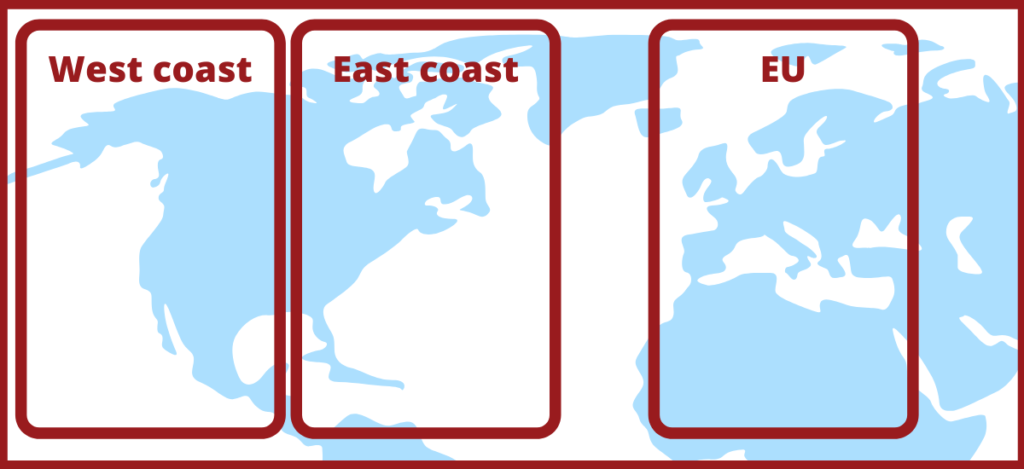
You can build your zones with our sales planner here.
Since you probably are not traveling, you can cast a wider net with your territory. This structure is going to give you the ability to structure your day efficiently.
You can readjust this depending on how much geography you want to cover. If you decide you want to focus in a specific area, or decrease the size of your territory, you can add those constraints. The principle of creating zones within a specific territory still applies.
Find target accounts
Now that you’ve structured your territory, its time find your target accounts. Then, place them in your territory zones.
We are increasing our sales from nothing. We need to go hunting for our target accounts. There are many ways to do this, but let’s go for simplicity and say we’ll use LinkedIn Sales Navigator.
First, we want to find our target companies. Determining the targets within those companies will come later. Use LinkedIn, or any other business database, to pull lists of companies that meet your target customer and are within your territory.
Once we have this list, you will place them in the zones you created above. We do this for organization and building our daily and weekly schedules.
Build your schedule
We understand our territory and we know what accounts we would like to target. Let’s build a schedule. We want to create order in our efforts to build our sales pipeline from nothing into something.
What we are going to do is take your zones and map them onto an actual calendar.
If you are using the geographic 5-zone system, you are going to map those onto days of the week. You will take the highest density zones and hit those one day every week. But, we are not going to hit the zones the same day each week. We want to plan for variation.
Then, the lower density zones, you will space out every other week. Lastly, you will have planned administrative days. This can either be half days on Monday morning and Friday afternoon. Or, a whole Monday or a whole Friday. You can space these out.
The result should be a monthly calendar that looks like the following:
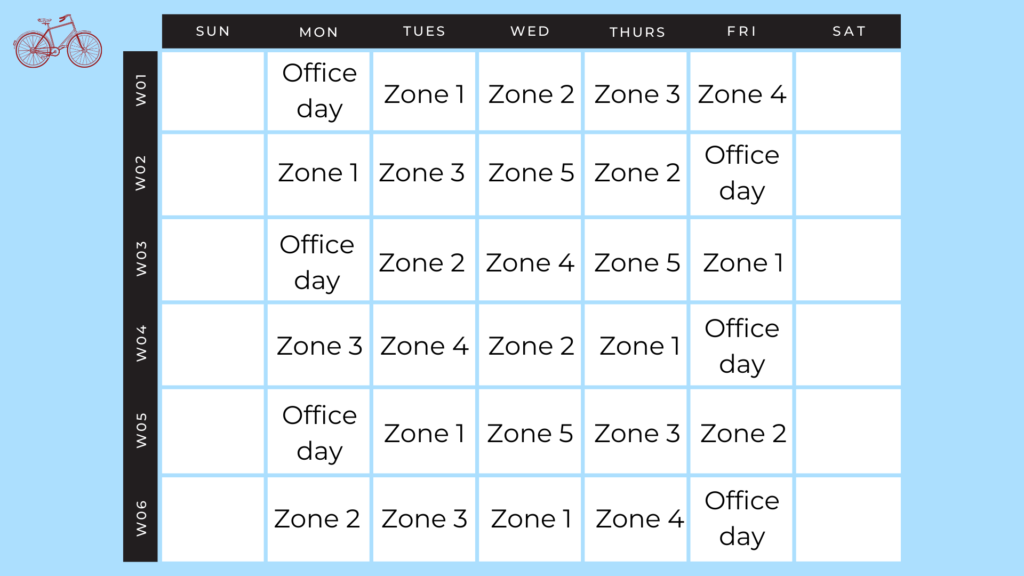
You can build your schedule with our sales planner here.
If you are working with the regional based zones (west coast, east coast, EU), you will have a different schedule. You will hit most of your regions every day. But, you will alternate early and late days to accommodate early time zones and late time zones. And, you’ll work in some administrative days.
The result will be a calendar that looks like the following:
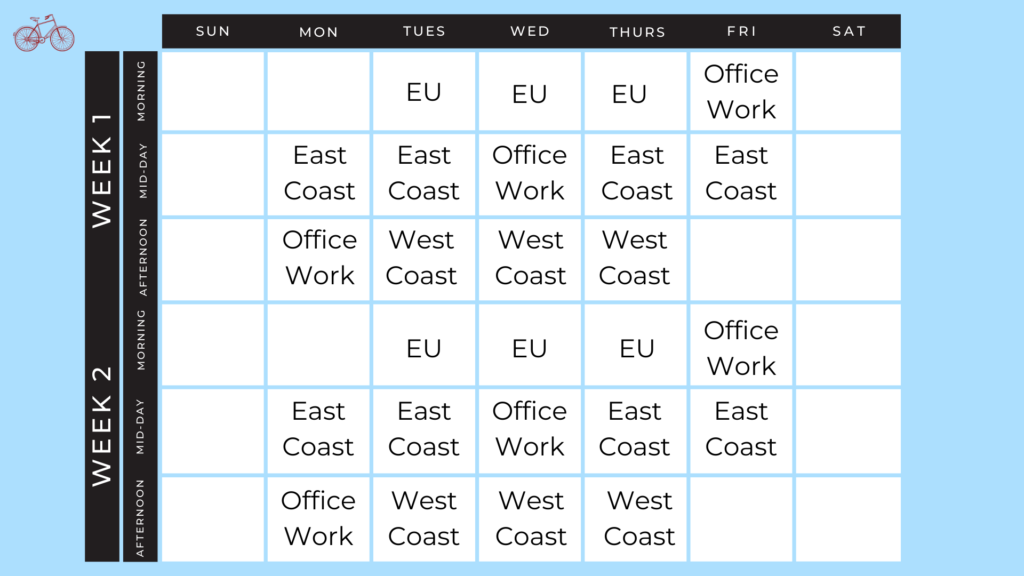
You can build your schedule with our sales planner here.
Both of these schedules will get you started. As you begin to get a feel for your territory, what’s working and what isn’t, you can adjust the schedules, target accounts, and zones.
Increase your sales with execution
We have created our plan. Now, it’s time to execute that plan. To increase your sales from $0, it is all about consistently executing principles. The principles are:
- Do the work
- Always fill your funnel
- Craft your message
- Become good
Do the work
Building sales from $0 is difficult and time consuming. We need to do the difficult, important work of consistently showing up and executing our plan from above. The work is about consistency, persistence, and patience.
Consistency
When talking about consistency, this means that we are consistently executing the plan above. If we are scheduled to be in Zone 2 on Wednesday, but we’re unable to schedule any confirmed meetings, we still drive out there and show up.
We work that zone like we planned. Cold calling, dropping in, better understanding the make-up of the territory. The idea is that we work each of our zones like they are territories in themselves.
This will build upon itself. And, it will never leave you asking the question, what should I do today?
Consistency also means you consistently maintain activity levels. This means you are sending the right number of prospecting emails. You are making the right number of phone calls. You are generating the appropriate number of meetings and quotes. These activity levels are things you can control.
Always control the controllables.
Persistence
Persistence falls into two categories. There is persistence in getting a meeting and there is persistence in the sales process.
The first is persistence in getting meetings. That means you are calling and emailing your prospects. As we want to be consistent in our efforts, we should build a systematic approach to make this manageable.
To do that, I create a three to four channel approach. When selecting target customers, target them a few different ways. This is what most tools allow you to do, called “sequencing”. You’ll mix a phone call and email sequence to prospects. If you are an outside sales professional, adding an office drop by to the highest priority customers is a great addition. Now, you are on their radar. You can add this element with direct mail or advertising as an inside sales professional. The goal is to get on the individual’s radar.
The second form of persistence is in the sales process itself. Which, is the part after the first meeting. During this, you want to ensure you follow up. A no today, doesn’t mean it’s going to stay a no forever. Continue the conversations as they make sense.
Patience
This process is going to take time. It will seem like lots of it. Budget 6-9 months of consistently doing this work before you begin seeing results.
Consistently show up and be persistent when you do and good things will come. You will begin to see some traction. Then, things will explode.
Always fill your funnel
As you begin to increase your sales, you might hit times where you are busy trying to close a few deals. During those periods, you have to ensure you continue prospecting.
You never want to let a busy day, week, or month take you away from prospecting and filling your funnel. That day of not doing it will come back to haunt you.
Based on our earlier schedule, work in cold calling and prospective client drop in opportunities. Your schedule, with this included, might look something like this:
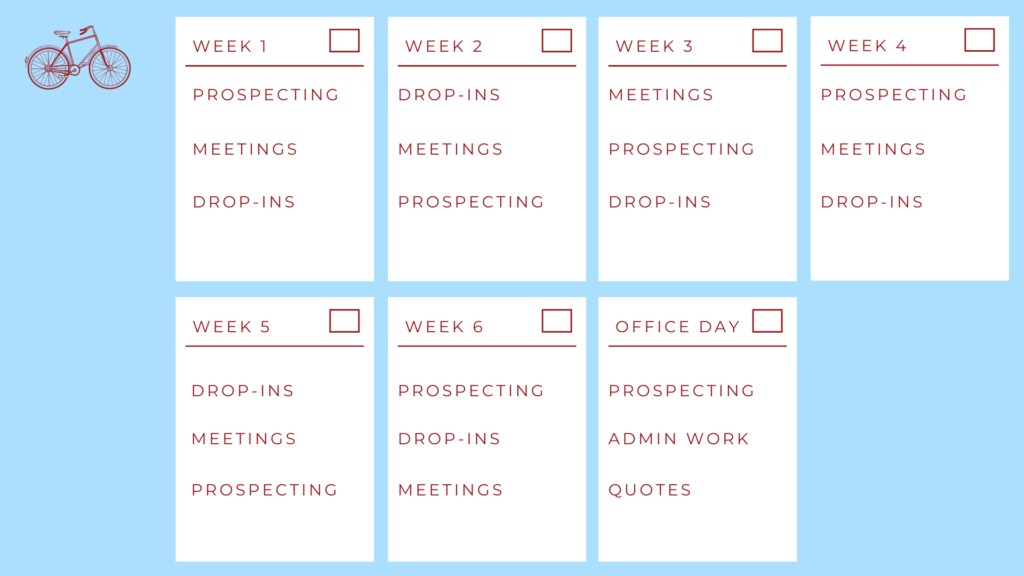
You can build your strategy with our sales planner here.
Always have something to do in those early days. You are making your own schedule and you have control over how busy it is.
Craft your message
As you start out, take this time to craft your message. Work on it while you are alone. You can do this commuting in your car.
Also test your message on prospects. Since you are beginning with $0 in sales, you will have a fair amount of time on your hands. Use that time to talk with people, whether cold calling or out and about, to test different messages.
Understanding what captures people’s attention is going to help build your sales.
Become good
During this process of building, you’ll be doing a lot of learning. Use that learning to get good at understanding what your clients actually need. Then, how do you get them onboarded to your product.
This is becoming the expert in your product. This allows you to present an accurate story of what their life is like currently. Then, explain how it will be once they begin working with you. It provides comfort to the prospect that they are going to be dealing with an expert.
This is building a pipeline that begins to sustain itself. You will have steady clients and steady revenue. This will begin to allow you to go after bigger deals and allow your territory to compound on itself.
To do that, we move into the management phase.
Management
As you begin to close a few clients, you don’t want to lose them. You want them to continue working with you and help you increase your sales through retention. You also need to continue your building activities.
To begin managing your new clients and maintain your building activities, there a few things you can do.
Be an account manager
The first shift in your role is going to be that of an Account Manager. You are no longer always trying to close for the first sale. It’s now a consultative approach.
Now you’re having conversations with your client about how to improve their business.
That could be helping them generate more revenue. Become more efficient. Or many other things that allow you to assist your client. This helps increase your client’s value to your business.
Increase your client’s value
As you’re managing accounts, the goal is to retain your client and increase the accounts value. If you are being consultative and finding ways to help their business, you’ll begin to find ways to upsell them.
This is one way you increase the client’s value. Having them purchase more products and services from you.
The second way you increase their value is retaining them as a client. If they have ongoing purchasing habits, continuing that purchasing increases their value as a client over time. This is behavior you want to encourage and facilitate.
You should dedicate time for finding ways to increase your client’s value. This brings us back to effectively planning for these activities.
Create a balanced schedule
As you begin managing your new clients, you’ll begin to wonder how you should shift your time allocation. We will do that by thinking about account management first. Then, building the schedules we created before around that.
It begins to look something like this.
First, we take our new accounts. We want to schedule meetings with them. Based on their value and purchasing patterns, we should bucket our companies four ways.
- Weekly: Top 5 accounts depending on purchase frequency.
- Bi-weekly: Top 5 accounts depending on purchase frequency.
- Monthly: Next 10 accounts.
- Quarterly: Next 25 accounts.
Early on, you may not have enough accounts to fill out all those options. That’s ok. You can fill them out as you build. It’s a framework.
With that framework, you can begin to take the schedules we built earlier and adjust them.
Now, you have a system to take care of your newly won business and continue adding new business. This will shift over time, so be flexible.
This is a blue print to increase your sales when there is none. It is not an easy road, but it can become fruitful. Follow these steps for 6-12 months and I am sure you will have a booming book of business.
Good luck and good selling.

